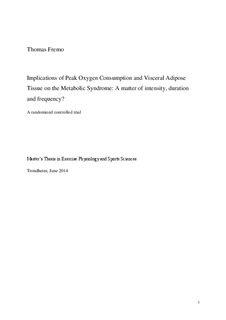| dc.description.abstract | The metabolic syndrome (MetS) is a socioeconomic concern on a worldwide scale. Visceral adipose tissue (VAT) accumulation is a fundamental component of the MetS, and the prevalence of abdominally obese individuals steadily increases. Cardiorespiratory fitness has shown to be an essential determinant in cardiometabolic health. Thus, it is a targeted remedy for improving the MetS. Objective: The present study aimed to assess how various loads of aerobic training (AT) would affect cardiorespiratory fitness, by means of peak oxygen consumption (VO2peak); whether this would associate with a reduction in visceral adipose tissue (VATA), and furthermore if this would have an effect on the MetS. Methods: 38 subjects diagnosed with the MetS were randomized in three groups; continuous moderate exercise (CME; n=14), 1 • 4 min aerobic interval training (1-AIT; n=11) and 4 •4 min aerobic interval training (4-AIT; n=13), and underwent a 16-week intervention. VO2peak was measured by use of direct ergospirometry, and direct segmental multi-frequency bioimpedance analysis (DSM-BIA) was applied to determine VATA. Results: The alteration of VO2peak did not differ significantly between groups at follow-up. However, CME increased VO2peak (p<0.05), which was accompanied by a reduction in VATA (p<0.05). Furthermore, the alteration of VO2peak and VATA inversely correlated (p<0.01). Body mass (BM) changed differently between groups (p<0.05). Coherently, there was a trend towards a dissimilar compliance between groups (CME compared with 1-AIT; p=0.056, 4-AIT; p=0.057). Finally, subjects that achieved the 25% highest positive alteration in either VO2peak or VATA had the most profound improvements in features of the MetS, by means of waste circumference (WC), diastolic blood pressure (BPd) and triglycerides (TG). Conclusion:Aerobic intensity still seems to be most effective by means of augmenting cardiorespiratory fitness if carried out adequately. Augmented VO2peak is associated with decreased VATA, and significantly affects the MetS. | nb_NO |
